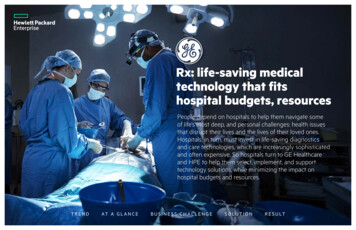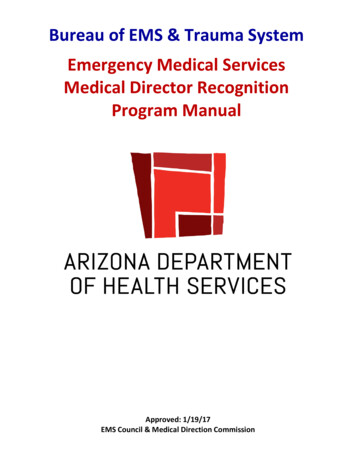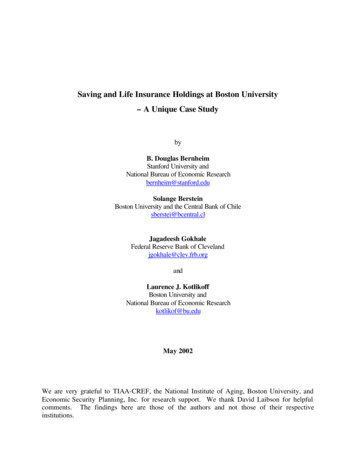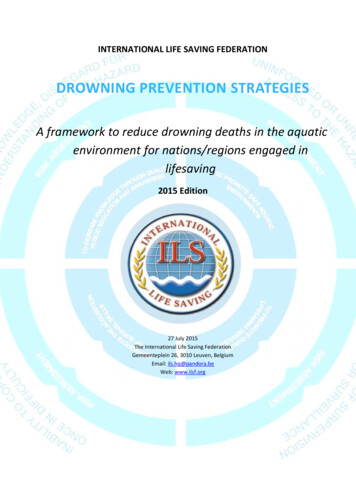
Transcription
Rx: life-saving medicaltechnology that fitshospital budgets, resourcesPeople depend on hospitals to help them navigate someof life’s most deep, and personal challenges: health issuesthat disrupt their lives and the lives of their loved ones.Hospitals, in turn, must invest in life-saving diagnosticsand care technologies, which are increasingly sophisticatedand often expensive. So hospitals turn to GE Healthcareand HPE to help them select, implement, and supporttechnology solutions, while minimizing the impact onhospital budgets and resources.TRENDAT A G L A N C EBUSINESS CHALLENGESOLUTIONR E S U LT
TRENDThe high stakes of cost versusquality of careHospitals must balance relentless pressure to keep costs undercontrol, while addressing the needs of aging populations, andembracing the promise of emerging medical solutions.Worldwide, people and the governments that serve them are grappling with the complex problem of health carecosts. Populations are growing but also aging: every year, there are more people who need care but fewer peopleof working age to help pay for it. Advancements in research, diagnostics, and treatment protocols are deliveringnew hope on countless medical fronts. However, many of these same advancements — breakthrough drugs,complex equipment, specialized protocols that draw on emerging research — carry additional potential to increasehealthcare costs.This puts hospitals in a difficult position. It would be inhumane to reduce costs by cutting back on care optionsor quality. There is also a limit to how much patients (or taxpayers, in cases where governments fund healthcareservices) can afford to pay for healthcare.Hospitals must therefore find ways to maintain high standards for patient care while also relentlessly seeking tominimize their costs.10% 1,318 2xof the world’s grossdomestic product (GDP)was spent on healthcarein 2014Average annual out-of-pocket medicalcosts for American workersIncrease in peopleaged 60 or olderworldwide between2007 and 2050
AT A G L A N C EMore healthcare, betterhealthcare, at a lower costGE Healthcare is helping to meet the world’s demand forincreased access, enhanced quality, and more affordablehealthcare around the world.GE Healthcare, a subsidiary of General Electric, is an American pharmaceutical company and medical equipmentmanufacturer headquartered in Chicago. The company provides medical imaging and information technologies,medical diagnostics, patient monitoring systems, drug discovery, bio pharmaceutical manufacturing technologies,and performance solutions services. GE Healthcare’s mission is to deliver better care, to more people around theworld, at a lower cost. 18.3BRevenues 201652Kemployees100 Countries worldwide served by GE Healthcare’s operations
BUSINESS CHALLENGEFocused on care, hospitals needmedical technology that fitsAll hospitals are dedicated primarily to serving the needs oftheir patients, but when it comes to medical technology,hospitals’ needs are always unique — and often, one-size-fits-allsolutions aren’t an option.To deliver healthcare today, hospitals must coordinate highly complex workflows, across multiple teams of caregivers,under time constraints that are often non-negotiable. Hospitals leverage medical technology to assist every step inthe delivery of care — from managing patient and clinical records, to diagnostics, communications, and delivery oftreatments. However, no two hospitals are identical. Each hospital requires medical, communications, and informationtechnology that is tailored to its specific requirements.Hospital clinicians depend on Picture Archiving and Communications Systems (PACs), for example, to transmit andstore radiology and cardiology images, diagnose patients, and foster collaboration within clinical teams. But eachhospital has unique constraints on how its PACs systems can be located, installed, and configured. Some hospitalsare housed in older buildings; the space for modern medical equipment may be limited. Each hospital is likely to haveunique requirements affecting how its PACs is integrated with other systems as well, including its network and itselectronic medical records platform.And while hospitals depend on technology, their primary focus is diagnosing and treating patients. They must avoidsolutions that require them to divert precious resources to managing technology instead of delivering healthcare.16.5Khospitals worldwide
SOLUTIONMedical technology innovationmade simpleDoctors and nurses are not IT experts. GE Healthcare and HPE aredesigning solutions that deliver the benefits of medical technologyinnovation quickly and simply.Medical technology, and the hospital eco-systems that surround them, have become increasingly complex.Hospitals need solutions that shield their end users — clinicians, care providers, and clinical support staff — fromthat complexity. GE Healthcare and HPE understand that. They’re partnering on healthcare solutions that draw oncutting-edge IT concepts, such as Software-Defined Infrastructure, containerization, and edge computing that maketechnology more usable and manageable.One example is GE Healthcare’s PACs solutions, which integrate imaging technology with HPE servers. In manyhospital settings, significant constraints affect how PACs systems can be sited and integrated with other hospitalsystems. To address this, GE Healthcare and HPE are refining the company’s PACs offerings to create “PACs in abox”-style solutions. Featuring a small footprint and self-contained architecture, these systems can be dropped intovirtually any hospital or clinical setting quickly and cost-effectively. GE Healthcare’s PACs systems are also bundled withHPE Pointnext services to deliver turnkey configuration, implementation, and support.SOLUTION RECIPEA partnership delivers turnkey medical technology solutionsGE Healthcare and HPE are collaborating to deliver increasingly sophisticated medical technology solutions.These include “PACs in a box”-style systems that integrate compute, storage, and networking hardware with GEHealthcare PACs technology and services from HPE Pointnext, including installation of the solution’s networkattached storage (NAS) and embedded HPE Foundation Care.HPE HardwareHPE Pointnext servicesHPE BladeSystemHPE Factory Express ServicesIntegrity ServersHPE Foundation CareProLiant ServersTransformation SolutionEnterprise Hybrid Cloud
R E S U LT SCaring for the caregiversWith the right design and support, medical technology giveshospitals the tools they need — without distracting them from thepatients they serve.Up to 40%Improvements in imaging procedure efficiencyBy making it simpler and easier for hospitals to implement, manage, and access medical technology, GE Healthcareand HPE are creating healthcare technologies that accommodate the requirements and constraints facing hospitalsand other healthcare providers, including clinics and imaging organizations.30%GE Healthcare Centricity PACS and Universal Viewer products, for example, boost efficiency and save radiologists’time compared to other PACs solutions. These gains, in turn, improve patient care by compressing diagnosis andtreatment workflows.Reduction in configuration costs makes PACs moreaffordable for larger numbers of imaging providersNext generation solutions like “PACs in a box”-style systems will build on these benefits with reduced system costsand space requirements.These considerations are particularly important to smaller providers (imaging organizations with volumes of100-350k exams per year) which may lack space for larger PACs configurations. By making it easier for theseorganizations to implement PACs, GE Healthcare and HPE are helping to expand the way imaging organizations canserve the needs of their patients—a critical consideration to improving the affordability and accessibility of healthcare.20 minutesPotential reduction in procedure times per studyLEARN MOREVIDEOPartnering to Improve HealthcareIT Technology Services: GE & HPEhpe.comView video Copyright 2017 Hewlett Packard Enterprise Development LPa00015174ENW
GE Healthcare's PACs systems are also bundled with HPE Pointnext services to deliver turnkey configuration, implementation, and support. SOLUTION RECIPE A partnership delivers turnkey medical technology solutions GE Healthcare and HPE are collaborating to deliver increasingly sophisticated medical technology solutions. These include "PACs in a box"-style systems that integrate compute .










